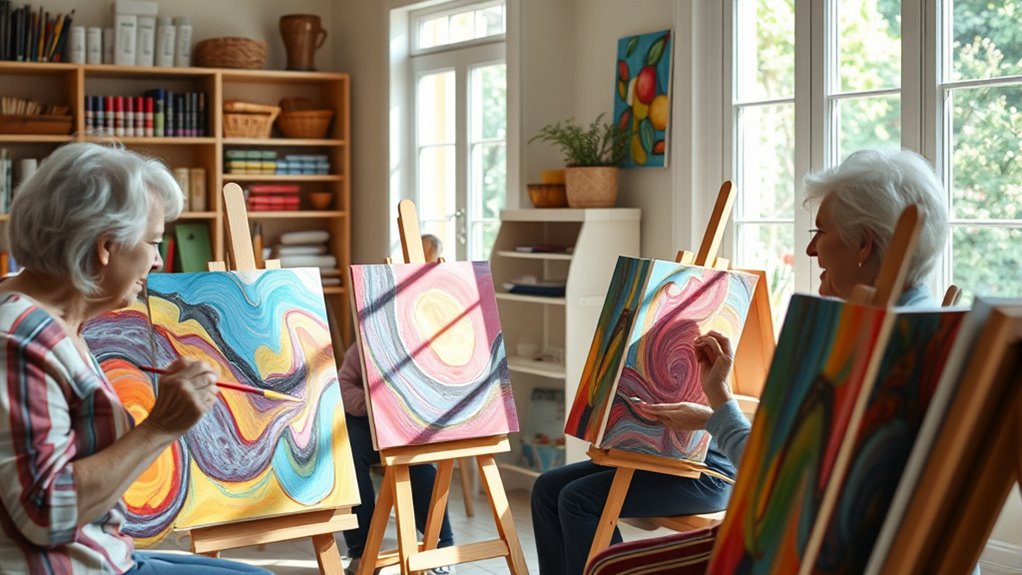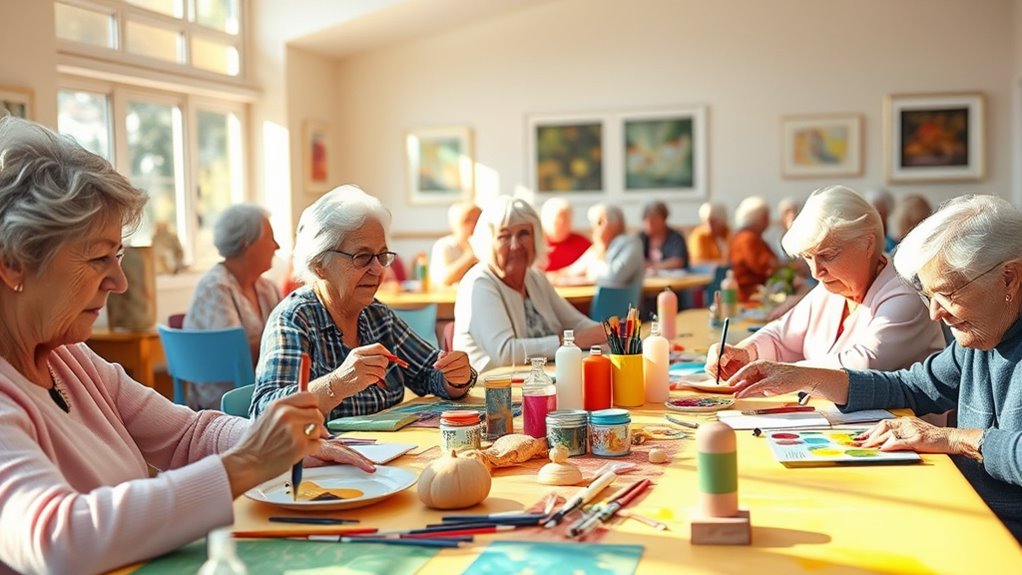Engaging in art therapy can considerably boost your memory and cognitive skills, helping you stay sharp as you age. Creating art helps activate neural pathways involved in memory recall and problem-solving, supporting mental resilience. It also offers a safe outlet to express emotions, which can improve emotional well-being. Participating in group art activities fosters social connections, reducing feelings of loneliness. Keep exploring these benefits to find gentle, enjoyable ways to nurture your mind and spirit.
Key Takeaways
- Art therapy stimulates memory recall by engaging seniors in creative activities that activate neural pathways associated with memory.
- It enhances cognitive health through problem-solving and planning, promoting mental sharpness and resilience.
- Non-verbal emotional expression in art therapy helps seniors process feelings, improving emotional well-being and self-awareness.
- Participating in art activities exercises cognitive skills like decision-making, boosting confidence and mental agility.
- Group art therapy fosters social interaction, reducing loneliness and supporting holistic mental, emotional, and social well-being.

Have you ever wondered how art therapy can benefit seniors? If you’re exploring ways to support a loved one or enhance your own well-being, understanding the power of creative expression might surprise you. Art therapy offers a unique approach to stimulating memory recall and fostering cognitive health, especially as we age. When seniors engage in creating art, they tap into their memories, often bringing long-forgotten moments to the surface. This process isn’t just about making pretty pictures; it’s a mental workout that encourages recalling past experiences, emotions, and details stored deep within the brain. As they choose colors, shapes, and textures, seniors activate neural pathways associated with memory, strengthening their ability to retrieve information and stay mentally sharp.
Art therapy stimulates memory, enhances cognition, and supports emotional well-being in seniors through creative expression.
The act of creating art also provides a non-verbal outlet for expressing feelings and thoughts. Sometimes, words fall short, especially when trying to communicate complex emotions or memories tied to personal history. Creative expression in art therapy gives seniors a way to convey their inner experiences visually, making it easier to process feelings related to aging, loss, or identity. This form of expression doesn’t require artistic perfection; instead, it emphasizes the process, allowing seniors to feel free and unjudged. As they put brush to canvas or mold clay with their hands, they’re engaging their brains in a meaningful activity that promotes emotional release and self-awareness.
Moreover, engaging in art therapy can improve overall cognitive functions by encouraging problem-solving, planning, and decision-making. When seniors decide what to create or how to approach their project, they exercise key mental skills that can slow cognitive decline. This active participation keeps their minds engaged, providing a sense of accomplishment that boosts confidence and motivation. It’s this combination of memory recall and creative expression that makes art therapy particularly effective for older adults. Not only does it stimulate mental processes, but it also fosters social interaction if done in group settings, further enriching the experience and combatting feelings of loneliness or isolation.
In essence, art therapy offers seniors a powerful tool to maintain their mental agility while exploring their inner worlds through creative expression. It’s a gentle yet impactful way to reinforce memory, enhance cognitive function, and nurture emotional health. By embracing this form of therapy, you support a holistic approach to aging—one that values the mind, heart, and the creative spirit.
Frequently Asked Questions
Can Art Therapy Help With Depression in Seniors?
Yes, art therapy can help with depression in seniors by encouraging emotional expression and boosting social engagement. When you participate in art activities, you can process feelings more openly, reducing emotional distress. Additionally, sharing artwork with others fosters social connections, which combat loneliness. This combination of emotional release and social interaction can considerably improve mood and mental well-being, helping seniors feel more connected and hopeful.
What Types of Art Are Best for Cognitive Improvement?
You should focus on visual arts and tactile crafts for cognitive improvement. Engaging in activities like painting, drawing, or collage stimulates your brain’s visual processing and fine motor skills. Tactile crafts such as clay modeling, knitting, or woodworking encourage sensory engagement and hand-eye coordination. These types of art not only boost memory and problem-solving but also provide enjoyable ways to keep your mind active and sharp.
How Often Should Seniors Participate in Art Therapy Sessions?
You should aim for art therapy sessions 1-2 times a week for seniors, as this frequency maximizes cognitive benefits without causing fatigue. Research suggests that consistent, ideal scheduling helps reinforce neural pathways and maintains engagement. By sticking to this routine, you create a stable environment that encourages memory improvement and cognitive growth. Regular sessions provide the mental stimulation needed to make art therapy effective and enjoyable for seniors.
Are There Any Risks or Contraindications for Senior Art Therapy?
You should be aware of safety considerations and emotional risks in senior art therapy. While generally safe, some seniors may experience frustration or emotional distress when expressing themselves creatively. Guarantee a supportive environment, monitor for signs of discomfort, and tailor activities to individual needs. Always consult with healthcare providers beforehand, especially if your loved one has physical limitations or mental health concerns, to minimize risks and promote positive experiences.
How Do I Find Qualified Art Therapists for Seniors?
To find qualified art therapists for seniors, start by checking their certification standards through reputable organizations like the American Art Therapy Association. Look for therapists who specialize in senior therapy programs and have experience working with older adults. You can also ask for recommendations from healthcare providers or senior centers. Make sure they hold valid credentials, and don’t hesitate to ask about their experience with memory and cognitive enhancement.
Conclusion
By engaging in art therapy, you may unlock hidden memories and boost your cognitive skills, supporting the idea that creative activities stimulate brain health. While some believe art therapy can reverse cognitive decline, even if it doesn’t fully prevent it, the joy and mental engagement it offers are undeniable. So, give yourself permission to create—your mind and memory could thank you for it, proving that art truly is medicine for the aging mind.









